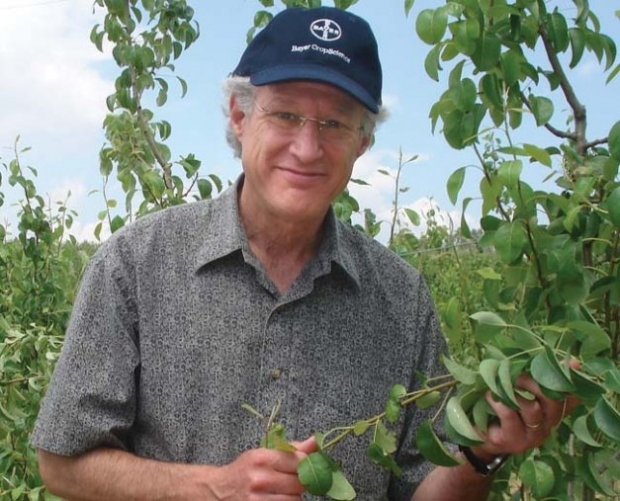
Orchard management can play an important role in minimizing postharvest decay in pears, says Dr. David Sugar, pathologist with Oregon State University in Medford.
For example, overabundant nitrogen promotes excess vigor in the trees, which tends to result in more nitrogen being shifted to fruit, and fruit with high nitrogen levels are prone to decay. High nitrogen in the trees, as well as a low crop density, increases competition between the shoots and fruit for calcium, resulting in low fruit calcium. “We have concluded that low-nitrogen, high-calcium fruit are the most resistant to decay in long-term storage,” Sugar said during a Pear School presented by Washington State University in Yakima this spring.
With moderate (adequate) vigor and orchard calcium sprays, the fruit can have a relatively high level of calcium, which protects against disease in two ways, Sugar said. First, calcium ions associated with pectins in the fruit directly inhibit decay enzymes. Calcium also delays the maturation of the fruit and slows down its aging process, which is a process of naturally losing resistance to decay.
These are not as powerful influences on fruit decay as fungicides, but they can be part of a holistic approach to dealing with decay, Sugar said.
Calcium treatments are most effective against wound rots (such as Cladosporium, Alternaria, and blue mold), Sugar said, but not against gray mold or against stem and calyx rots.
Wounding
Another good strategy to minimize decay is to reduce the amount of wounding of fruit. For a study, Sugar visited 14 orchards during harvest and sampled 100 fruit from each of ten bins of Bosc pears. He tested the fruit to see if firmer fruit was less prone to wounding, but only found a very weak relationship between firmness and wounding. When he looked at the amount of wounding and how the pickers were paid, he found a striking relationship. Bins picked by workers who were paid by the bin had 14 percent wounded fruit on average, versus only 4 percent wounding in fruit picked by workers paid by the hour.
Orchard management
An accumulation of plant debris on the orchard floor is a source of nourishment for certain fungi and can lead to population increases. The more debris is on the orchard floor, the more spores are produced that can land on the fruit surface, ready to become decay organisms when the fruit is wounded.
Good air movement and sunlight penetration also affect the amount of fungi that are in the orchard and end up on the fruit ready to cause decay. Also, the later the harvest, the higher the risk of rot. Fruit should be harvested promptly once it reaches the right maturity range, Sugar suggested.
Calcium
For a three-year research project, he looked at the effects of preharvest calcium sprays and a combination of preharvest calcium and fungicide sprays on the percentage of infected wounds in Bosc pears. The pears were given a postharvest treatment of thiabendazole (TBZ, sold under the brand name Mertect) within 24 hours of harvest or up to eight weeks after harvest. Sugar applied calcium three times between mid-July and late August but warns that there can be some leaf burn with high levels of calcium chloride. He used a rate of 3 pounds of calcium (about 9 pounds of calcium chloride) in 100 gallons of water, and applied 200 gallons per acre.
In all treatments, the percentage of infected wounds increased the later the TBZ was applied.
Fruit treated with calcium had fewer infections than the control, and the fungicide-treated fruit had less decay still. Fruit that was treated with both calcium and a preharvest fungicide had a very low incidence of infection, even when the TBZ treatment was delayed by eight weeks.
In trials where the postharvest fungicide Scholar (fludioxonil) was used instead of TBZ, the trends were similar, although the incidence of decay was lower overall.
With no preharvest treatments and only a postharvest fungicide, the amount of decay increased dramatically the longer the treatment was delayed.

Leave A Comment